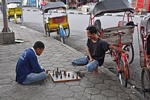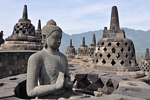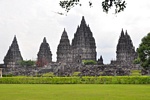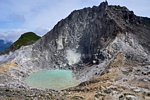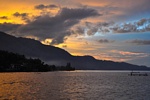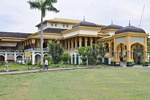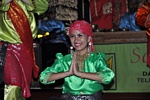Indonesia, May 2009 and Nov/Dec 2016.
Text by Usha Alexander, Dec 2016.
Indonesia is one of the world’s largest and most diverse countries comprising over 3,500 tropical islands, in a vast range of shapes and sizes, inhabited by over a quarter billion people and scattered across 735,000 square miles of ocean at the junction where the Indian Ocean meets the Pacific. Though officially an Islamic country (the world’s largest), some of its communities practice their own unique forms of Hinduism, Buddhism, and folk religions; even the practice of Islam is heavily syncretized with earlier belief systems, though there are movements for adherents to move toward a more orthodox Muslim practice, in keeping with global trends. Though the national language is Bahasa Indonesia (Indonesian), the country remains home to over 700 languages. Indonesia's dominant culture and style seem to come out of the region of Jakarta, the national capital, and Java island in general, masking the true ethnic and historical diversity of the islands.
Beginning perhaps a little over two-thousand years ago (long before Europeans arrived), the island trade networks expanded to include India; this exchange provided a conduit for cultural influences from the subcontinent to seep through the archipelago, especially the largest western islands—Sumatra, Java, Borneo, and Bali. Chief among the ideas and practices arriving from India were the belief systems we now call Hinduism and Buddhism, along with their associated artistic, literary, and political traditions, which blended with local traditions and belief systems, forever altering the cultural substrate of the region.
For us, arriving from India, the cultural influences of South Asia were immediately apparent, particularly in Sumatra, Java, and Bali, where the Indian epic of Ramayana has taken on its own local significance and furnished material for particular styles of indigenous dance drama and puppet theater. One can also see—particularly at Borobodur and Prambanan, where the sculpture is so similar to contemporary (~900 CE) Indian art—that Indian sculptors must have arrived and toiled and trained local artists en masse to influence the aesthetic ideals of these islands. Though in other artworks it’s equally clear that the islanders infused their own style and sensibility to create uniquely syncretic traditions. Even today, Indonesia remains one of the places on earth where telling people you’re from India actually carries a certain cachet—everyone is eager to name their favorite Bollywood star (currently Shah Rukh Khan is king)!
The first millennium CE was a time of great political and social upheaval in the archipelago as local leaders took on the mantle of Hinduism and Buddhism, terraced paddy farming spread and large-scale irrigation works were constructed, trading ports vied for dominance, and social inequality increased toward more feudal structures. The early second millennium saw the arrival of Islam, as Muslim Indians and Arabs joined into the mix of traders, and Arabs came to dominate Indian Ocean trade. Like Hinduism and Buddhism before it, Islam seeped in through trading contacts and influence, blending with ancient ancestor worship and other folk traditions, as well as the pre-existing Hindu and Buddhist beliefs, until local rulers converted to Islam. But Islam spread much farther east than Hinduism or Buddhism had done. Today, Islam exists in multiple unique, syncretic forms across the islands. Talking to locals even casually about religion reveals the multiple and nuanced levels of syncretism, for example, in the widespread fascination for the stories of the Ramayana tradition.
It was predominantly Muslim sultanates that the Europeans met when they arrived in the sixteenth century. The Dutch, with their superior firepower, were able to subdue the dominant sultanates swiftly enough, though the Acehnese, of northern Sumatra, continued to route them in decades of bloody guerrilla-style warfare, becoming among the last of the islanders to submit to colonial rule. (In the eastern part of the archipelago, entire populations of smaller islands were sometimes decimated or enslaved.) In Java, Dutch sited their capital, Batavia. From there they built and administered a Dutch colonial society under the Dutch East Indies Company (VOC), and for hundreds of years all the human labor and economic potential of the archipelago was bent toward the enrichment of the Netherlands.
Dutch colonialism ended abruptly when the Japanese brutally occupied the islands during World War II. With the defeat of the Japanese in 1945, Indonesia found itself among the first artificially constructed colonial nations to become independent. Since then, Indonesia has had a tryst with authoritarian communism, followed by a bloody, authoritarian backlash, and then some decades of relative stability and economic growth. Today, Indonesia is experimenting with a highly decentralized form of democratic government, where decisions are relegated to its dozens of provinces. Most of Indonesia's population and wealth remain on the western islands, particularly on Java, while the rest of the country remains sparsely populated. Mining concessions granted by the government to foreign contractors have led to labor disputes and human rights concerns on the outer islands. And due to agriculture concessions granted, Indonesia today suffers the highest rate of deforestation in the world, as huge swathes of tropical forests are cleared for palm oil plantations.
Bali, 2016 |
|||
|
The island of Bali lies a mile east of the island of Java, separated by the narrow Bali Strait. Most of Bali is mountainous, the highest point being Mount Agung, or Bali Peak, 3,142 metres high and known locally as the “navel of the world.” Balinese life is centered on religion—a blend of Hinduism (especially that of the Shaivite sect), Buddhism, Malay ancestor cult, and animistic and magical beliefs and practices. Places of worship are numerous and widespread, and there is a firm belief in reincarnation. Caste is observed, though less strictly than is the case in India. The great majority of the population belongs to the Sudra, the lowest caste. The nobility is divided into priests (Brahman), the military and ruling royalty (Kshatriya), and the merchants (Vaishya). Some Muslims and Chinese live in northern and western Bali, and there are a few Christians. The Balinese language is distinct from that of eastern Java, but the upper-class form contains many Javanese and Sanskrit words. All Balinese villages have temples and an assembly hall, usually located on a square that serves for festivals and markets. Typical family homes have a compound surrounded by earthen or stone walls. —Adapted from Encyclopedia Britannica |
|||
|
|||
Lombok, 2016 |
|||
|
Lombok is the major island immediately to the east of Bali, across the narrow Lombok Strait. About 3.5X the size of O’ahu in Hawai’i, but with only 3.3 million people, it remains relatively sparsely populated, a green, agrarian haven. Over two-thirds of the people live in Mataram and in farming villages in its agricultural heartland spanning the central valley of the island's interior. The local language is Sasak, which occurs in several of its own distinct dialects, sharing roots with Balinese and the languages of Sumbawa to the east. |
|||
Java, 2009, 2016 |
|||
Sumatra, 2009 |
|||
|
|||
Designed in collaboration with Vitalect, Inc. All rights reserved. |
















